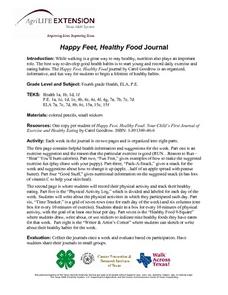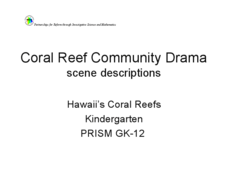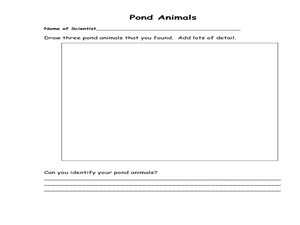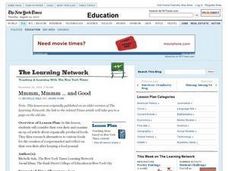Curated OER
Little Bees, Big Potential
After reading an article on the alfalfa leafcutting bee, learners chart its characteristics alongside those of the honeybee. Then they draw the leafcutter lifecycle. The article provides fascinating reading when studying the role of...
Curated OER
A Home for a Cricket
First graders build a habitat for crickets after studying animal survival needs. They care for and observe the crickets in the classroom habitat.
Curated OER
9th Grade
Ninth graders discuss the principal source of energy entering the marine ecosystem. They name some of the autotrophs at the Maui Ocean Center. Students name some of the heterotrophs at Maui Ocean Center. They are taught that plants are...
Curated OER
Bacteria
Students study the advantages and disadvantages of bacteria. In this bacteria lesson plan students draw and label the different types of bacteria.
Curated OER
Food Chains and Webs
For this food chains worksheet, learners identify the producers and consumers in the given food chains and describe how contaminants can biologically accumulate. This worksheet has 4 short answer questions.
Curated OER
Genetically Modified Foods
Students explain what genetically modified foods are and how they are created. Students use appropriate vocabulary to describe and effectively discuss the benefits of, and potential risks of, genetically modified foods.
Curated OER
Health: Food Borne Illnesses
Students discover how to inhibit food borne illnesses by practicing safe food-handling techniques. Among topics they examine are the advantages and disadvantages of using wooden or plastic cutting boards. After studying for the test,...
Curated OER
Transforming Food Energy: A Balancing Act
Pupils explain their role as consumers. They use a purchased calorimeter or make their own simple calorimeter to measure the energy content in selected foods. This interesting lesson really gets students thinking about what they eat.
Curated OER
Micro-organisms
Students learn what a micro-organism is. In this micro-organism lesson, students understand that micro-organisms may be too small to see. Students learn microorganisms could be bacteria, fungi, something beneficial or a harmful microbe....
Curated OER
Happy Feet, Healthy Food Journal
Fourth graders record their physical activities and eating habits in a journal. They place their answers in the workbook, Happy Feet, Healthy Food. They sketch and write about their weekly healthy habits.
Curated OER
Coral Reef Community Drama: Scene Description
Students are organized into groups and are assigned puppets according to what sea creature their group represents. For this reef lesson, students identify sea creatures according to their place in the food chain then discuss how these...
Curated OER
Pond and Pond Organisms
Students explore pond ecosystems. In this pond organism activity, students will use pond water and a plastic bad in order to locate and identify freshwater organisms. The activity is designed for younger grades, but...
Curated OER
Wacky Wildlife World
Fourth graders research organisms in the environment in Kentucky and create brochures for the local area wildlife reserves. Individuals create brochures that include information on habitat, body characteristics, scientific class, role...
Curated OER
Comparing Microscopic Organisms in Fresh and Polluted Water: An Invitation To Inquiry
Students have the opportunity to develop and formulate ideas and explanations through the scientific standard of inquiry. They identify organisms by using an identification key for specific aquatic geographical area.
Curated OER
Understanding Food Labels
Students determine the number of calories, serving size, and vitamins and minerals in different food products and use this information to create a formula determining the number of calories per serving size and the daily percentages of...
Curated OER
Graphic Favorite Breakfast Foods
Second graders graph data based on a class survey of their favorite breakfast foods. In this graphing lesson plan, 2nd graders take a class survey of their favorite breakfast foods. Then they take that data and put it into a computer...
Curated OER
Ecosystem Organization - Lesson Plan
Student explore ecosystems. In this ecosystem organization lesson, students consider how scientists study living organisms. Students participate in a teacher guided activity that requires them to visualize an organism and imagine its...
Curated OER
East Meets West
Students explore the influences of culture in food choices and customs. They compare and contrast information to create a menu using a Web site and Student Writing Center. Suggestions for creating an on-line graphic organizer as well as...
Curated OER
Sorting
Students experience sorting. In this organization lesson, students play a computer sorting game called "Flood Game" on the "Between the Lions" website. Students visit a library and observe and discuss book organization. Students work in...
Curated OER
Mmmm, Mmmm ... and Good
Students consider their own diets and examine an op-ed article about organically produced foods. They research alternatives to various foods for the creation of a supermarket and reflect on their own diets after keeping a food journal.
Curated OER
Biomes of the World (and Canada)
Students explore environments by analyzing food chains. In this biome identification lesson, students define a list of environmental vocabulary terms such as tundra, rain-forest and desert. Students create a fictional self sustainable...
Curated OER
You Are What You Eat: Lessons from Alice Waters
Students view the AMERICAN MASTERS episode titled ALICE WATERS AND HER DELICIOUS REVOLUTION. They examine their own eating habits and determine how they can eat food that is both healthier and tastier. Through Guided Reading strategies,...
Curated OER
Edible Algae
Students acquire an awareness and appreciation for the value of the organisms in the Protist Kingdom. They identify common Protists, name them and list some common products that contain marine algae.
Curated OER
Whst Makes You Tick?
Eleventh graders explore the major organs of the circulatory system. In this circulatory system lesson, 11th graders create, identify and describe parts of the system. Students view a list of major organs and predict what their job is....
Other popular searches
- Con Pair Organic Foods
- Organic Foods Taste
- Non Organic Foods
- Com Pair Organic Foods
- California Organic Foods
- Compair Organic Foods
- Conpair Organic Foods
- Organic Foods Lesson Plan























